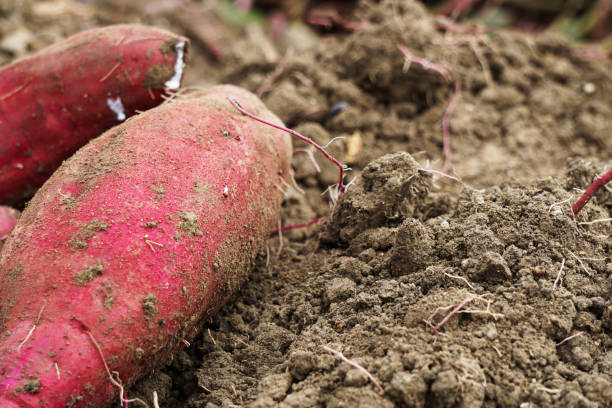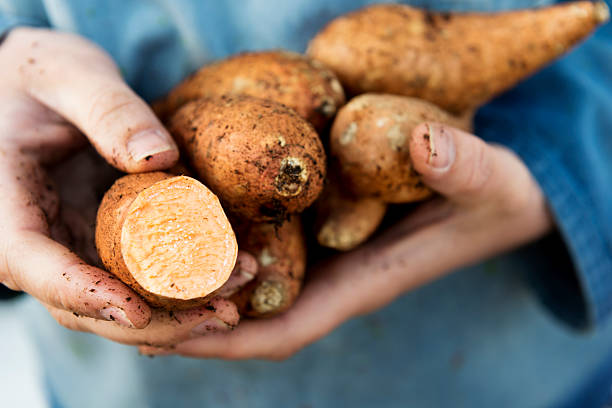
Welcome to our comprehensive guide on planting, growing, and harvesting sweet potatoes. In this article, we will provide valuable insights and step-by-step instructions to help you cultivate these delicious root vegetables in your backyard. Whether you’re an experienced gardener or a novice, our detailed guide will equip you with the knowledge and tips necessary to grow sweet potatoes quickly and confidently.
The Delightful Sweet Potato: A Nutritious and Versatile Vegetable
Sweet potatoes are a treat for your taste buds and a nutritional powerhouse. Packed with minerals, fiber, and phytonutrients, they offer many health benefits. Incorporating sweet potatoes into your dinner menu can be a delicious way to enhance your overall well-being. And the best part? You can easily grow them in your backyard, regardless of the quality of your soil.
Choosing the Perfect Spot for Sweet Potato Growth

To ensure the optimal growth of sweet potatoes, it’s important to select the right location in your garden. These warm-weather crops thrive in sunny areas, particularly in well-drained soil. While sweet potatoes can adapt to various soil conditions, they flourish best in a vegetable garden with ample sunlight. Keep in mind that sweet potatoes require approximately 85 to 120 days to reach full maturity, so plan your planting accordingly.
Selecting the Ideal Sweet Potato Varieties
With over 400 varieties of sweet potatoes available, choosing the right one for your garden can be a daunting task. To help you make an informed decision, we have compiled a list of recommended sweet potato varieties:
- Beauregards: These sweet potatoes feature dark-reddish purple skin and typically take around 90 days to mature.
- Bush Porto Ricos: Ideal for small gardens, these copper-colored sweet potatoes require approximately 110 days to grow.
- Centennials: Known as America’s most popular sweet potatoes, Centennials boast carrot-orange flesh and reach maturity in about 100 days.
- Georgia Jets: With their red skin and deep orange moist flesh, Georgia Jets are fast-growing sweet potatoes that mature within 90 days.
- Stokes: If you’re looking for a variety suitable for savory dishes, Stokes sweet potatoes are an excellent choice. They have purple skin, rich purple flesh, and take approximately 120 days to mature. Moreover, they are higher in Vitamin C content compared to orange sweet potatoes.
- Vardamans: With their short vines and attractive blue or purple foliage, Vardamans are perfect for small gardens. They feature reddish-orange flesh and are ready to harvest in a relatively short time.
- White Yams: This variety, also known as “White Triumph,” exhibits white skin and white flesh. White yams are one of the oldest sweet potato varieties and typically take 100 days to mature.
Planting Sweet Potatoes: Step-by-Step Instructions

Now that you have selected your preferred sweet potato variety and found the perfect spot in your garden, it’s time to start planting. Follow these step-by-step instructions for a successful sweet potato cultivation:
- Preparing the Soil: Sweet potatoes can grow in poor soil conditions, but heavy clay or sandy soil may result in deformed roots. Create long, wide ridges approximately 10 inches high, spaced 3½ feet apart. Incorporate plenty of compost into the soil, avoiding nitrogen-rich fertilizers that promote excessive vine growth and stunted tuber development. In colder regions, covering the raised rows with black plastic helps retain heat and facilitates robust growth.
- Acquiring Root Sprouts (Slips): Sweet potatoes are typically grown from root sprouts called slips. You can find these slips at nurseries or order them from reputable suppliers. Avoid using store-bought sweet potatoes for sprouting, as they are often treated with wax to prevent sprouting. To produce your slips, save a few healthy sweet potato roots from your previous crop. a. Pre-Sprouting Process: Around six weeks before the ideal outdoor planting time in your area (typically three to four weeks after the last spring frost), place the sweet potato roots in a box filled with moist sand, sawdust, or chopped leaves. Keep the box in a warm spot with temperatures ranging from 75 to 80 degrees Fahrenheit. Sprouts will emerge, and once they reach a length of 6 to 9 inches, cut them off the root. b. Preparing Slips for Planting: Remove and discard the bottom inch of each slip, as this portion may harbor disease organisms. Plant only the healthy and vigorous slips, as they are more likely to yield robust sweet potato plants.
- Planting the Slips: Sweet potatoes require full sun and warm soil to thrive. Wait until the last frost has passed and the soil has warmed before planting. Dig holes approximately 6 inches deep and space them 12 inches apart. Gently bury the slips, leaving only the top leaves above the soil surface. Firmly press the soil around the slips and water thoroughly.
Cultivating Sweet Potatoes: Tips for Successful Growth

Once your sweet potato plants are established, it’s essential to provide them with the proper care to ensure healthy growth and a bountiful harvest. Here are some valuable tips to keep in mind:
- Mulching and Weed Control: If you’re not using black plastic, mulch the vines approximately two weeks after planting. This helps smother weeds, retain moisture in the soil, and promote favorable conditions for root development. Occasionally lift longer vines to prevent them from rooting at the joints, as this can divert energy from ripening the main crop.
- Watering: Sweet potatoes require consistent moisture during their growing period. If the weather is dry, provide approximately 1 inch of water per week until two weeks before harvesting. At that point, allow the soil to dry out slightly. Be cautious not to overwater, as sweet potatoes can withstand dry spells better than excessive moisture.
- Pest and Disease Management: While sweet potatoes are generally tolerant of pests and diseases, it’s essential to be vigilant and take necessary preventive measures. Here are some common pests and diseases to be aware of: a. Sweet Potato Weevils: These insects can cause damage to the roots and spread foot rot. To mitigate their impact, use certified disease-resistant slips and practice a four-year crop rotation. Destroy infected plants and their roots to prevent further infestation. b. Black Rot: This disease manifests as circular, dark depressions on tubers. Remove and discard infected potatoes, ensuring to cure undamaged roots carefully.
- Differentiate black rot from less severe scurf, which appears as small, round, dark spots on the tuber surface without affecting its eating quality. c. Stem Rot: Stem rot, or wilt, is a fungal disease that primarily affects injured plants. Minimize the risk by planting only healthy slips and opting for resistant cultivars. Additionally, maintain optimal conditions by avoiding excess moisture and keeping the fleshy roots at temperatures between 55 and 60 degrees Fahrenheit. d. White Rust: This fungal infection is characterized by chalk-white blisters on the undersides of leaves and on flowers and stems. Combat white rust by removing infected plants and implementing crop rotation practices. e. Whiteflies and Flea Beetles: These pests can threaten sweet potatoes. Whiteflies leave a sooty substance on leaves, causing them to wilt and stunt growth. Use vacuuming or insecticidal soap to control whiteflies. Flea beetles, on the other hand, create tiny holes in leaves. Utilize row covers and companion planting with beneficial insect-attracting plants such as dill and marigolds to deter flea beetles.
Harvesting and Storing Sweet Potatoes
The time to reap the rewards of your sweet potato cultivation will come when the leaves start to yellow. However, allowing the crop to remain in the ground for a longer duration will yield higher quantities and enhanced vitamin content. Once the vines have been blackened by frost, it’s time to harvest the tubers.
Follow these steps for successful sweet potato harvesting:
- Digging the Tubers: Select a sunny day with dry soil for harvesting. Use a garden fork or shovel to carefully dig up the tubers. Remember that sweet potatoes can grow a foot or more away from the plant, so dig cautiously to avoid damaging the tender skin, which can lead to spoilage.
- Curing the Tubers: After harvesting, dry the tubers in the sun for several hours. Then, transfer them to a well-ventilated area with temperatures between 85 and 90 degrees Fahrenheit. Maintain these conditions for 10 to 15 days to ensure proper curing.
- Storing Sweet Potatoes: Once the sweet potatoes have been cured, store them at a temperature of around 55 degrees Fahrenheit with a humidity level of 75 to 80%. Properly cured and stored sweet potatoes can last for several months, allowing you to enjoy your homegrown produce throughout the year.
Frequently Asked Questions
Are sweet potatoes easy to grow?
Yes, sweet potatoes are relatively easy to grow, thanks to their tolerance for heat and drought. They are also less susceptible to pests and diseases compared to many other vegetables. While they thrive in warmer areas, they can be cultivated in various regions with the right care and conditions.
Can sweet potatoes be grown indoors?
Absolutely! Sweet potatoes can be grown indoors, especially in locations where you can provide optimal temperatures. As they are sensitive to heat and cold, choose a sunny spot near a south-facing window with indirect bright light for indoor cultivation.
Can I grow sweet potatoes from a whole sweet potato?
Sweet potatoes are typically grown from slips, rooted sprouts from mature potatoes. While you can use whole sweet potatoes from the market, purchasing slips from nurseries or suppliers is best to ensure successful growth. A single sweet potato can produce three to five slips, depending on the variety.
Essential Supplies for Successful Sweet Potato Growth
To set yourself up for success in growing sweet potatoes, having the necessary supplies is essential. Here are some must-have items:
- Garden Fork: A sturdy garden fork is essential for digging up sweet potatoes during the harvest. Look for a durable fork that can withstand the task at hand.
- Garden Soil: Quality garden soil enriched with compost is crucial for creating a fertile environment for sweet potatoes. Consider using a mix incorporating compost, sand, and high-potassium fertilizer to promote optimal growth.
- Plastic Sheeting: If you use black plastic to cover your raised rows, select high-quality plastic sheeting to retain heat and promote robust growth effectively.
Following our comprehensive guide, you are well-equipped to embark on your sweet potato gardening journey. Enjoy the process of cultivating these nutritious and delicious root vegetables in your backyard, and savor the satisfaction of harvesting your very own homegrown sweet potatoes.






